Step into the sizzling world of teppanyaki, a captivating culinary tradition that has delighted palates for centuries in Japan. Picture a skilled chef masterfully grilling and cooking an array of delectable ingredients on a scorching iron griddle, while putting on a mesmerizing show. From succulent steaks to fresh seafood, sizzling vegetables to aromatic rice, each dish is crafted with precision and finesse. If you’re ready to embark on an adventure filled with tantalizing flavors, thrilling cooking techniques, and an interactive dining experience, then this article is your passport to the realm of teppanyaki.
What is Teppanyaki?
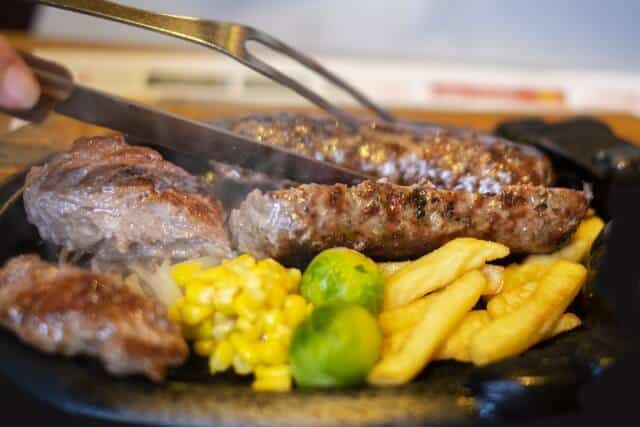
Teppanyaki, a Japanese culinary style, involves the skillful grilling or cooking of various ingredients on an iron griddle called a teppan. It showcases a diverse range of food such as steak, hamburger, yakiniku, jingisukan, monjayaki, okonomiyaki, and kaisenyaki. These are artfully seasoned with a blend of soy sauce, garlic, ginger, and other traditional Japanese flavors. The chef’s expertise comes to life through techniques like chopping, stir-frying, and grilling, resulting in a harmonious fusion of flavors and textures. Beyond the delightful cuisine, teppanyaki offers an interactive dining experience. The chef’s captivating cooking skills and entertaining showmanship create an engaging atmosphere, where they interact with customers, perform tricks, and often engage in lively conversation.
Teppanyaki History
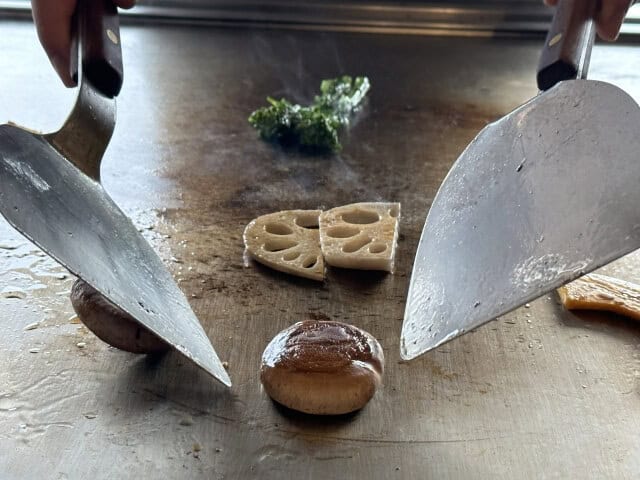
The tradition of grilling food in Japan dates back to the early days when direct-fire grilling was practiced. Over time, cooking methods shifted to firewood-fueled stoves, and during the Edo period, charcoal braziers became a common means of heating. However, due to the limited availability of gas stoves, heating an iron plate to the cooking temperature at home was impractical, given the high value placed on iron as a commodity.
Following the war, the popularity of cooking on iron plates soared as food prepared in this manner became accessible through black markets and food stalls. Even prior to the war, dishes like okonomiyaki and monjayaki had embraced the concept of cooking on iron plates. Teppanyaki found its place in dining out experiences, camping trips, and festive occasions. In modern times, the widespread use of electric hot plates has made it convenient for people to enjoy teppanyaki in the comfort of their own homes.
Today, each teppanyaki genre boasts its own unique cultural identity, featuring specialties such as okonomiyaki, teppanyaki steak, and teppanyaki noodles. The evolution of teppanyaki has been shaped by historical factors, culinary innovation, and the desire for convenient and enjoyable dining experiences.
Charm of Teppanyaki
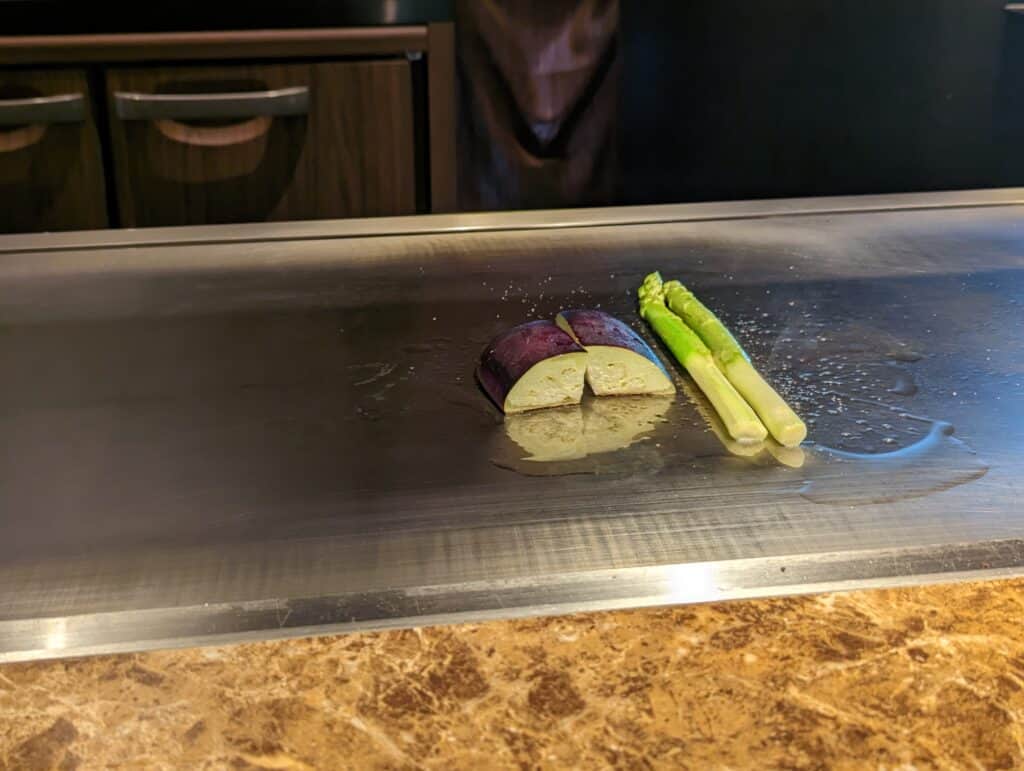
Teppanyaki offers a range of charms, but its greatest appeal lies in the immediate enjoyment of freshly grilled food. The visual delight of witnessing appetizing ingredients cooked right before your eyes adds to the overall experience. Teppanyaki restaurants provide a captivating atmosphere, where the combination of the enticing grilled ingredients, the powerful presence of the iron plate, and the sizzling sounds and aromas stimulate your appetite and enhance the flavors of the food. Skillful heat control and precise grilling by professional chefs are vital factors in achieving deliciousness. Furthermore, some establishments offer additional attractions, such as impressive flambé performances and expert manipulation of cooking utensils, further enhancing the teppanyaki experience.
Merits of cooking meat on Teppanyaki

Cooking Kobe beef on a Teppanyaki grill offers several advantages that elevate the dining experience and accentuate the meat’s unique qualities. The even heat distribution of Teppanyaki grills ensures that the beef cooks uniformly, resulting in a tender and perfectly cooked piece of meat. The high heat used in Teppanyaki cooking develops a rich, caramelized crust on the beef, enhancing its flavor and adding delicious charred notes. The quick cooking time and high heat also seal in the juices, keeping the meat succulent and moist. Additionally, the interactive dining experience of having a skilled chef perform cooking tricks and engage with diners adds excitement and entertainment to the meal. Teppanyaki grills also allow for customization, enabling diners to request their preferred level of doneness, seasoning, and accompaniments, further enhancing their overall dining satisfaction.
Typical ingredients of Teppanyaki
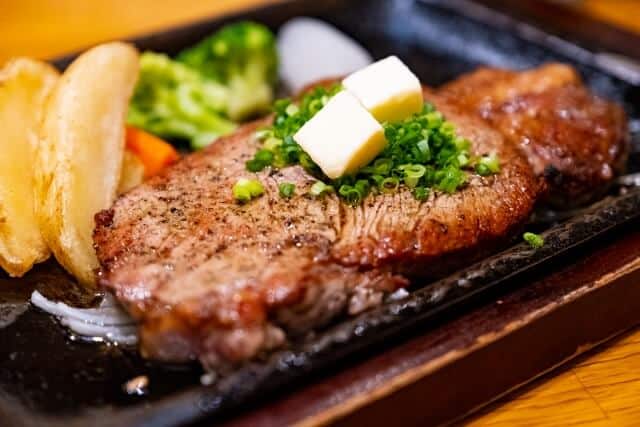
Teppanyaki utilizes various ingredients to create flavorful dishes. In general teppanyaki, commonly used ingredients include chicken breast, mushrooms, zucchini, green peppers, and asparagus. These ingredients are seasoned simply with oil and soy sauce. Another popular option is beef and chicken teppanyaki, which combines beef, chicken, peas, onions, green peppers, and mushrooms, seasoned with salt and pepper. Salmon teppanyaki involves baking the salmon in the oven and seasoning it with salt and pepper, often paired with carrots, bean sprouts, and mushrooms. Additionally, teppanyaki enthusiasts favor ingredients such as wieners, sausages, yakiniku (grilled meat), diced steak, yakisoba (stir-fried noodles), gyoza (dumplings), and dishes like omurice (omelet rice) and fried rice. These ingredients contribute to the rich variety and popularity of teppanyaki cuisine.
Teppanyaki FAQ
- Why does the meat cook so deliciously when the iron plate is thick?
-
When observing the grilling process, placing meat on a slightly elevated iron plate causes a sharp decrease in temperature for thin plates. This effectively applies brakes to prevent overall burning. In contrast, thicker iron plates facilitate better temperature control, accommodating variations in meat thickness and size, resulting in easier management of the grilled meat.
- What is the most important thing when grilling meat?
-
Do not use over medium heat. Because it’s the easiest to adjust the doneness. It is easy to track changes with the naked eye.
Teppanyaki Recipe
Teppanyaki Ingredients
| Ingredients of Teppanyaki for 4 persons | Measurements |
|---|---|
| Beef (for grilled meat) | 400g |
| Squid (body part) | 125g |
| Shrimp | 50g |
| Scallop (boiled) | 80g |
| Salad oil | 15g |
| Lettuce (or lettuce, salad greens, etc.) | 100g |
| Apple | 40g |
| Vegetables of your choice | 50g |
| [Seasoning] Onion (grated) | 20g |
| [Seasoning] Garlic (grated) | 24g |
| [Seasoning] Soy sauce | 70g |
| [Seasoning] Honey | 14g |
| [Seasoning] Red wine | 14g |
| [Seasoning] Salt | 2g |
| [Seasoning] Pepper | 3g |
How to make Teppanyaki
Place the meat in a bowl, add half of the mixture in seasonings, and mix well to season the meat.
Cut the vegetables into bite-sized pieces and cut the squid into round slices and remove the back veins from the shrimp.
Heat the iron plate, spread salad oil on it, line up the scallops from 1 to 3, and grill them.
Where to buy Teppanyaki
Kamon (鉄板焼 嘉門)
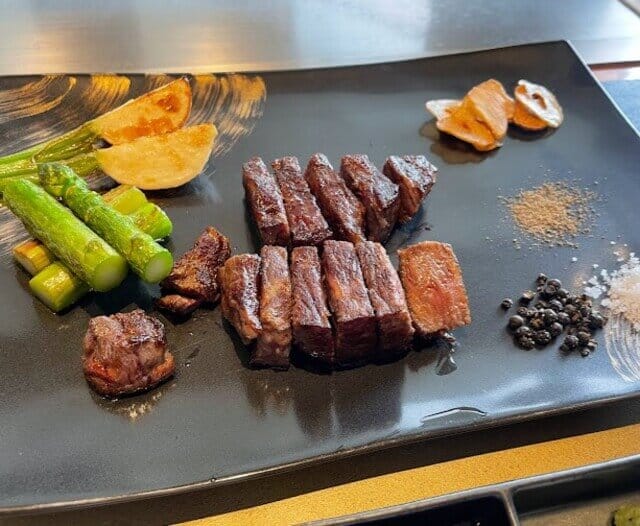
In this restaurant, you can enjoy teppanyaki with the theme of meeting and fusion of Japanese and Western cuisine to your heart’s content. While utilizing the skills and knowledge of French cuisine, they also apply the spirit of hospitality to the Japanese food culture of teppanyaki.
Shichirigahama (鉄板焼き 七里ガ浜)
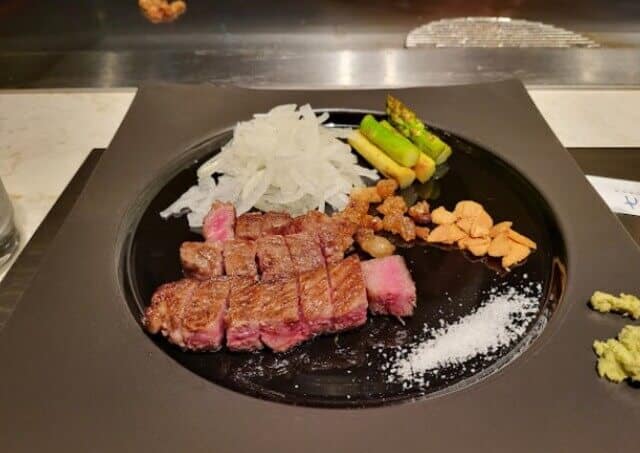
You can enjoy cooking in a spacious and calm atmosphere in a magnificent location that you don’t usually see. Private rooms are also available, so please spend irreplaceable time for various purposes such as dates, entertainment, and special anniversaries. You can enjoy carefully selected local ingredients with carefully selected wines. They offer dishes that resonate with all five senses, such as the sound of grilling ingredients, the process of cooking, and the fragrant aroma of grilled ingredients.
Aburi Meat Wakuro (あぶり肉工房 和黒 新神戸店)
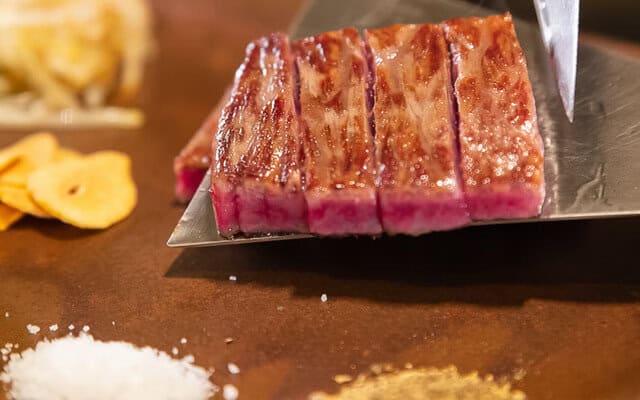
It is a teppanyaki-style steak restaurant where a skilled chef cooks live on an iron plate in front of you. The restaurant’s most popular course, the Special Waguro Course, is a special course featuring 200 grams of specially selected Kobe beef, which has cleared the strictest conditions among Tajima beef. There are counter seats for teppanyaki, table seats for steaming and shabu-shabu, and a salon with a spacious sofa table so that you can fully enjoy Kobe beef, the top brand of wagyu beef that Hyogo Prefecture is proud of.
Final Thoughts
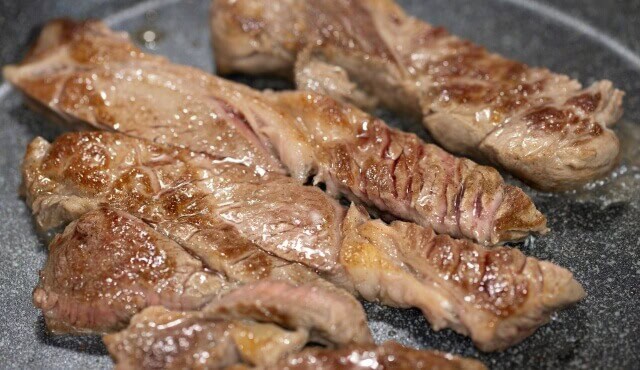
Teppanyaki, with its captivating grilling techniques, interactive dining experience, and diverse range of flavorful ingredients, holds a special place in the culinary landscape of Japan. From its historical origins to its evolution into a global phenomenon, teppanyaki continues to enchant food enthusiasts around the world. Through this article, we hope you have gained a deeper understanding of the rich history, cultural significance, and tantalizing flavors that teppanyaki has to offer. So, next time you seek an extraordinary dining experience, step into the world of teppanyaki and immerse yourself in the artistry and flavors that make it truly remarkable.
You can check some Japanese grilled dishes that we know you would like to try too.






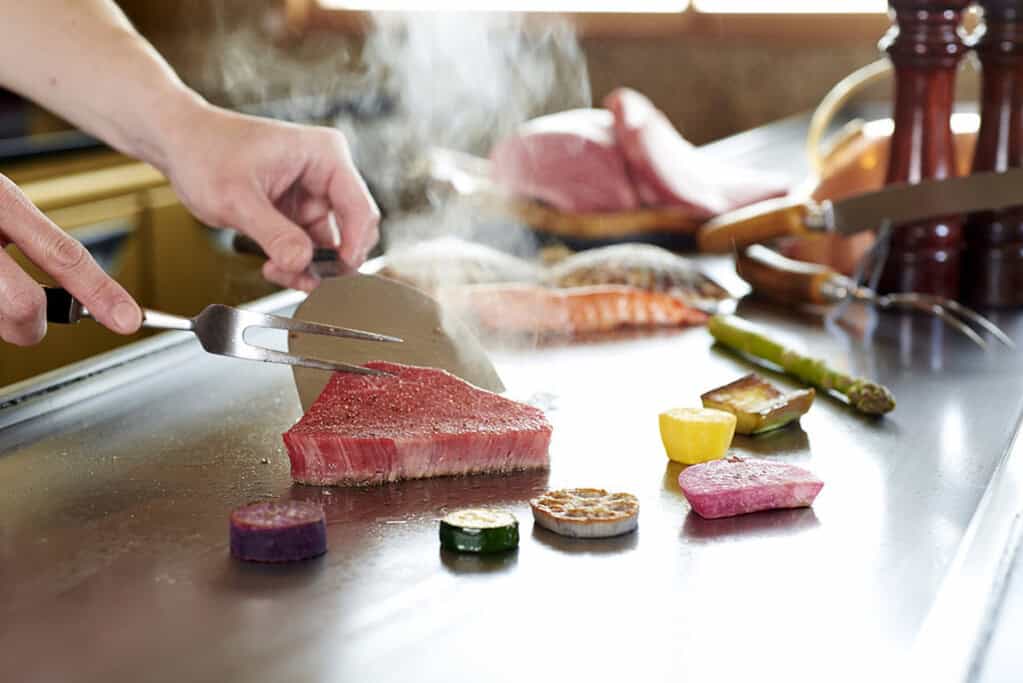
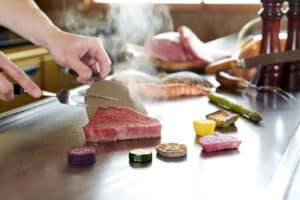

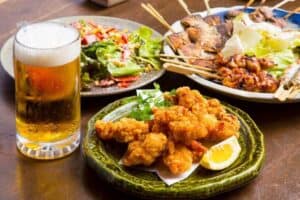
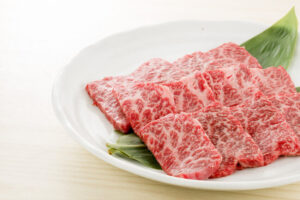
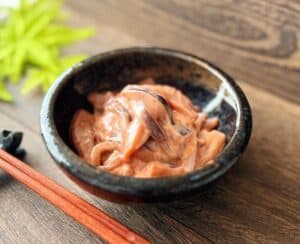
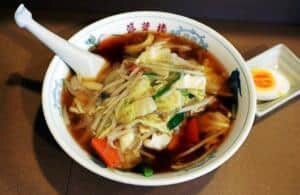
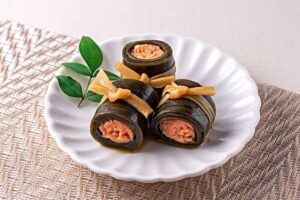
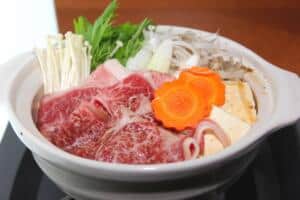

Comments